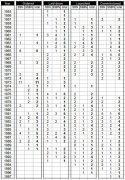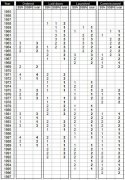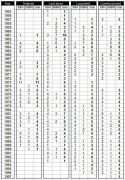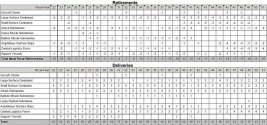Just to chip in a little.
There is a French submarine expert called Eric Genevelle. He had a long article about the 09-IV. He deleted it since then. There he argued there were 7-9 09-IV classes in service. He could identify 4 different variants using photo evidence from holes in the outer hull.
Let's take the middle figure, i.e. 8x 094s currently in service with the PLAN.
Now, let's tabulate.
SSN: 5x 091s & 9x 093/As
SSBN: 1x 092 & 8x 094/As
Total number of nuclear submarines constructed from 1974 until 2019: 23
Time elapsed from 1974 until 2020: 47 years
This means on average,
from 1974 until 2020, China has a
production rate of
0.489 boats per year.
Compare this to what we do know of China's plans regarding the nuclear submarine fleet for the 14th Five Year Plan (2021-2025) - 8x 093B SSNs, 1x 095 SSN and 2x 094B SSBNs. That would be 11x nuclear submarines in total.
(Once again, I use the designation 094B to refer the aforementioned 094As with larger SLBM launch tubes.)
11 nuclear submarines in 5 years would equate to a
production rate of
2.2 boats per year.
From 0.489 to 2.2 - That's a massive jump for sure.
However, for myself, I think this production rate may have been a little low, considering the PLAN's immediate need for such boats in light of the geopolitical scenario in the WestPac, and given the newly expanded and upgraded construction capabilities thanks to the many new facilities being added to Huludao.
There are several possible explanations for this (or any combination of):
1. Huludao is still lacking significantly in the manpower, facilities, resources and budget that can be utilized for a mass-scale construction of nuclear submarines. In other words, Huludao is having the problem of 力不从心;
2. Huludao is still training up its workforce and setting up the construction facilities for an even larger nuclear submarine production in the 15th Five-Year-Plan period (2026-2030). To put it simply, Huludao is still in warming up its muscles;
3. The PLAN is still working on, but close to, finishing the final touches on the designs and engineering of the 095 SSN and 096 SSBN. Which means, they do not intend to rush the procurement of newer SSNs and SSBNs until they are absolutely confident that the 095 and 096 are ready;
4. What we do publicly know regarding the number of nuclear submarines which Huludao plans to build within the 2021-2025 timeframe is not the complete picture. In short, this 局座 guy is doing his thing.
 "You thought you already knew everything about future Chinese nuke boat procurement? Sike, think again!"
"You thought you already knew everything about future Chinese nuke boat procurement? Sike, think again!"
Just in case anybody's wondering - I didn't include the rumored "mini-nuke" submarines into the calculation. This is because we have:
1. No confirmation on whether the "mini-nuke" sub is an actual thing or just an inflatable decoy;
2. No viable estimation on the number of procurement for these subs available; and
3. No confirmation/denial on whether Wuchang would be involved in their construction, apart from Huludao -
In order to justify their inclusion.






